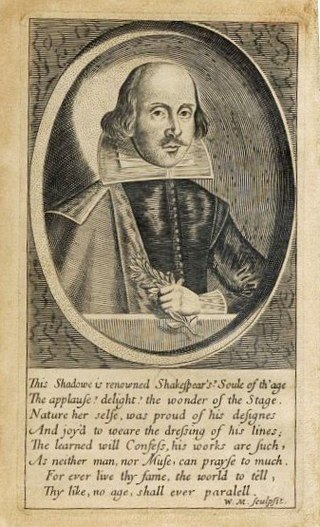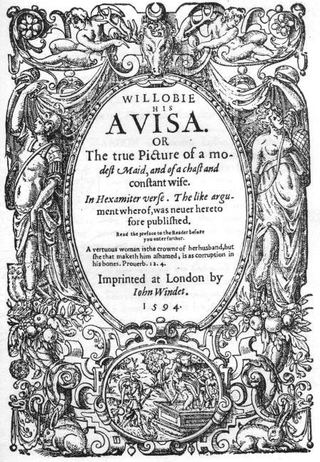
The Oxfordian theory of Shakespeare authorship contends that Edward de Vere, 17th Earl of Oxford, wrote the plays and poems of William Shakespeare. While historians and literary scholars overwhelmingly reject alternative authorship candidates, including Oxford, public interest in the Oxfordian theory continues. Since the 1920s, the Oxfordian theory has been the most popular alternative Shakespeare authorship theory.

William Shakespeare was an English playwright, poet and actor. He is widely regarded as the greatest writer in the English language and the world's pre-eminent dramatist. He is often called England's national poet and the "Bard of Avon". His extant works, including collaborations, consist of some 39 plays, 154 sonnets, three long narrative poems, and a few other verses, some of uncertain authorship. His plays have been translated into every major living language and are performed more often than those of any other playwright. Shakespeare remains arguably the most influential writer in the English language, and his works continue to be studied and reinterpreted.

The earliest texts of William Shakespeare's works were published during the 16th and 17th centuries in quarto or folio format. Folios are large, tall volumes; quartos are smaller, roughly half the size. The publications of the latter are usually abbreviated to Q1, Q2, etc., where the letter stands for "quarto" and the number for the first, second, or third edition published.
Richard Barnfield was an English poet. His obscure though close relationship with William Shakespeare has long made him interesting to scholars. It has been suggested that he was the "rival poet" mentioned in Shakespeare's sonnets.

Samuel Daniel (1562–1619) was an English poet, playwright and historian in the late-Elizabethan and early-Jacobean eras. He was an innovator in a wide range of literary genres. His best-known works are the sonnet cycle Delia, the epic poem The Civil Wars Between the Houses of Lancaster and York, the dialogue in verse Musophilus, and the essay on English poetry A Defense of Rhyme. He was considered one of the preeminent authors of his time and his works had a significant influence on contemporary writers, including William Shakespeare. Daniel's writings continued to influence authors for centuries after his death, especially the Romantic poets Samuel Taylor Coleridge and William Wordsworth. C. S. Lewis called Daniel "the most interesting man of letters" whom the sixteenth century produced in England.

William Shakespeare (1564–1616) wrote sonnets on a variety of themes. When discussing or referring to Shakespeare's sonnets, it is almost always a reference to the 154 sonnets that were first published all together in a quarto in 1609. However, there are six additional sonnets that Shakespeare wrote and included in the plays Romeo and Juliet, Henry V and Love's Labour's Lost. There is also a partial sonnet found in the play Edward III.

Henry Wriothesley, 3rd Earl of Southampton, was the only son of Henry Wriothesley, 2nd Earl of Southampton, and Mary Browne, daughter of Anthony Browne, 1st Viscount Montagu. Shakespeare's two narrative poems, Venus and Adonis and The Rape of Lucrece, were dedicated to Southampton, who is frequently identified as the Fair Youth of Shakespeare's Sonnets.

Venus and Adonis is a narrative poem by William Shakespeare published in 1593. It is probably Shakespeare's first publication.

The Shakespeare apocrypha is a group of plays and poems that have sometimes been attributed to William Shakespeare, but whose attribution is questionable for various reasons. The issue is not to be confused with the debate on Shakespearean authorship, which questions the authorship of the works traditionally attributed to Shakespeare.

Mr. William Shakespeare's Comedies, Histories, & Tragedies is a collection of plays by William Shakespeare, commonly referred to by modern scholars as the First Folio, published in 1623, about seven years after Shakespeare's death. It is considered one of the most influential books ever published.

Sonnet 138 is one of the most famous of William Shakespeare's sonnets. Making use of frequent puns, it shows an understanding of the nature of truth and flattery in romantic relationships. The poem has also been argued to be biographical: many scholars have suggested Shakespeare used the poem to discuss his frustrating relationship with the Dark Lady, a frequent subject of many of the sonnets. The poem emphasizes the effects of age and the associated deterioration of beauty, and its effect on a sexual or romantic relationship.

John Benson was a London publisher of the middle seventeenth century, best remembered for a historically important publication of the Sonnets and miscellaneous poems of William Shakespeare in 1640.

False Folio is the term that Shakespeare scholars and bibliographers have applied to William Jaggard's printing of ten Shakespearean and pseudo-Shakespearean plays together in 1619, the first attempt to collect Shakespeare's work in a single volume. There are only two complete extant copies. One is part of the collection of the Folger Shakespeare Library in Washington, DC. The other is held in the Special Collections at Texas Christian University in Fort Worth, Texas.

Richard Field (1561–1624) was a printer and publisher in Elizabethan London, best known for his close association with the poems of William Shakespeare, with whom he grew up in Stratford-upon-Avon.
William Jaggard was an Elizabethan and Jacobean printer and publisher, best known for his connection with the texts of William Shakespeare, most notably the First Folio of Shakespeare's plays. Jaggard's shop was "at the sign of the Half-Eagle and Key in Barbican."
Peter Short was an English printer based in London in the later Elizabethan era. He printed several first editions and early texts of Shakespeare's works.
John Smethwick was a London publisher of the Elizabethan, Jacobean, and Caroline eras. Along with colleague William Aspley, Smethwick was one of the "junior partners" in the publishing syndicate that issued the First Folio collection of Shakespeare's plays in 1623. As his title pages specify, his shop was "in St. Dunstan's Churchyard in Fleet Street, under the Dial."

The spelling of William Shakespeare's name has varied over time. It was not consistently spelled any single way during his lifetime, in manuscript or in printed form. After his death the name was spelled variously by editors of his work, and the spelling was not fixed until well into the 20th century.

Willobie His Avisa is a narrative poem that was published as a pamphlet in London after being entered in the Stationers' Register on 3 September 1594. It purports to have been written by a person called "Henry Willobie" with an introduction by "Hadrian Dorrell". It is possible that these are pseudonyms, though a real Henry Willobie certainly existed.
John Clapham (1566–1619) was an English historian and poet.





















